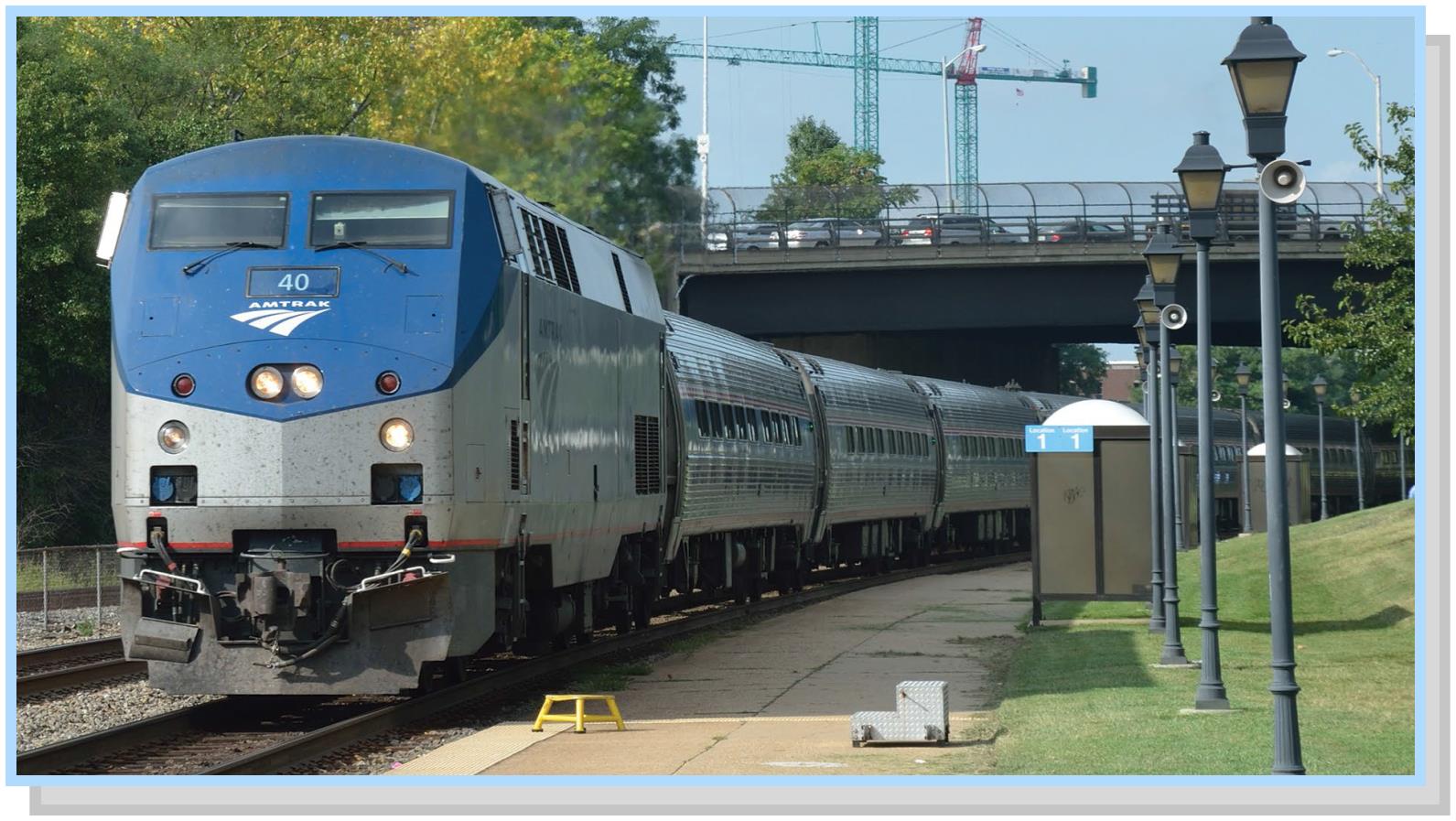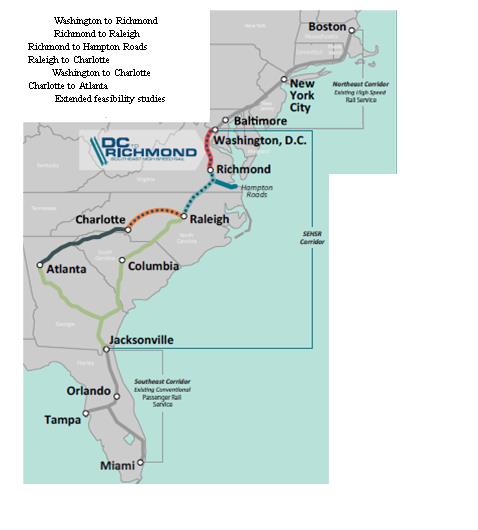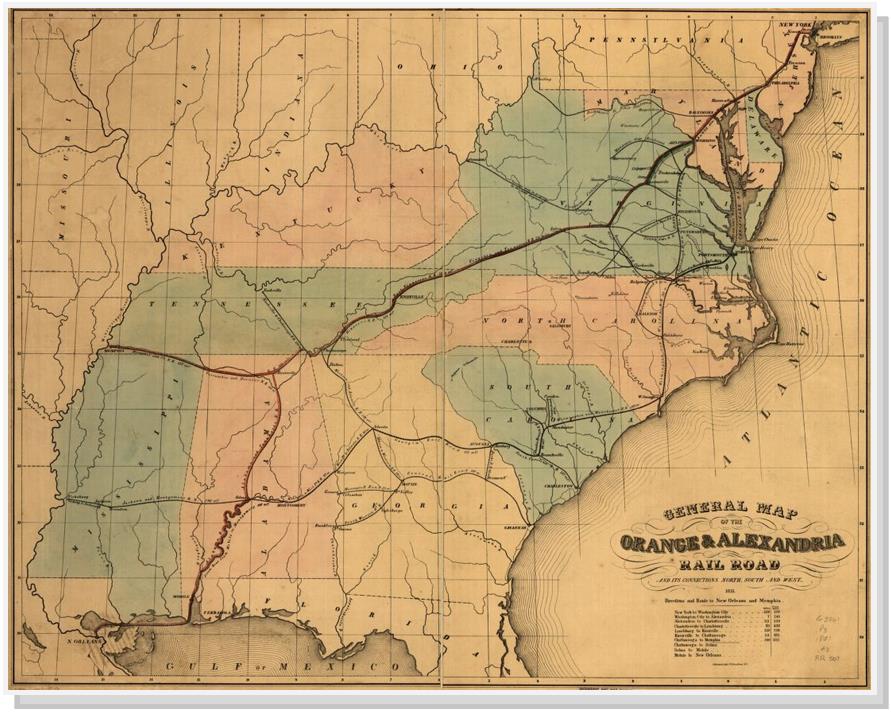
At Last, High Speed Passenger
Rail to Richmond
 Over the past two hundred years, trains have dramatically changed both industry and the settlement of nations. From steam trains to the modern Bullet Trains, millions of passengers, and ton upon ton of freight have been carried to all corners of the earth. The development of many civilizations can even be mapped by train routes. Just look at the journey from the east coast of the US to the west. It used to take up to two months, but with the dawn of train travel, it could be accomplished in a few days.
Over the past two hundred years, trains have dramatically changed both industry and the settlement of nations. From steam trains to the modern Bullet Trains, millions of passengers, and ton upon ton of freight have been carried to all corners of the earth. The development of many civilizations can even be mapped by train routes. Just look at the journey from the east coast of the US to the west. It used to take up to two months, but with the dawn of train travel, it could be accomplished in a few days.
Today, urban environments depend on underground systems to carry millions of commuters each day. Over 40% of worldwide goods are carried by train between communities and countries. There is also a well-deserved romanticism associated with train travel. The simple mention of the Flying Scotsman, The Yankee Clipper, the Spirit of the Outback, or the Himalayan Queen conjures images of fine dining, amazing scenery, masterful engineering feats, and leisurely travel.
Let’s face it, however necessary automobile travel to points south of Washington may be, it is stressful. Between the congested highways, hold-ups, accidents and increased trucking traffic, a trip even as short as to Richmond is not pleasant. The good news is that the Virginia Department of Rail and Public Transportation and the Federal Railroad Administration are working to improve the 123 mile passenger rail service between Washington, D.C. and Richmond in a corridor shared by growing volumes of passenger, commuter, and freight rail traffic. Opening this line will provide a competitive transportation choice by increasing intercity passenger rail capacity and improving travel times.
This significant segment of rail will provide the critical & final link between the heavily traveled Northeast Corridor rail line from Boston to Washington, D.C. and the rest of the south east corridor, enhancing public mobility and connectivity by providing faster, more frequent, and more reliable passenger rail service (90mph) along the eastern seaboard. In order to develop this rail link, additional tracks and other infrastructure improvements are being considered with a number of studies underway that will specify the improvements required.
Multiple benefits are anticipated for the traveling public as well as the Commonwealth of Virginia, including:
- Improving the frequency, reliability, and travel time of intercity passenger rail operations in Virginia and beyond, and providing a competitive alternative to highway and air travel.
- Increasing the capacity of the shared freight-passenger rail system between Washington, D.C., and Richmond and beyond.
- Improving modal connectivity with other public transportation systems within the corridor to further expand travel options for passengers within Virginia and beyond.
- Improving freight and passenger rail safety in the corridor by improving highway-rail grade crossings.
- Improving air quality and reducing greenhouse gas emissions by diverting passenger trips from automobiles and movement of freight by trucks to more environmentally sustainable rail transportation.
What’s the Need for D.C. to Richmond High Speed Rail?
- Population growth and changing demographics are leading to increased demand for reliable and safe travel options.
- Demand for freight transportation through and within the corridor is expected to grow.
- The I-95 corridor remains congested, and trip times are unreliable.
- Travel by air is increasingly at capacity which causes travel delays.
- The shared freight and passenger rail corridor between Washington, D.C. and Richmond is nearing capacity.
- The transportation network must provide options for reliable and convenient movement of goods and people.
- There is a need to reduce growth of transportation related mobile source emissions and the resultant impacts to air quality.
Due to the complex nature of passenger rail programs, projects must go through various phases of development before the new or improved service can be initiated. From start to finish, a typical passenger rail project can take several years to complete.
An aggressive schedule of project development has been undertaken with the preliminary engineering project slated for completion in late 2017. This will be followed by final design and construction, and then, passenger service will begin.
In addition to the improvements being considered as part of the DC to Richmond project, portions of the corridor are currently undergoing other enhancements.
There is 11.4 miles of third main-line track under construction between Arkendale and Powell’s Creek in Stafford and Prince William Counties, including Marine Corps Base Quantico. In addition, VRE is building 2.6 miles of additional third main-line track between Hamilton and Crossroads, south of Fredericksburg. The VRE project will also construct a longer yard lead track to accommodate a new Spotsylvania Station. Passenger stations will include side or center island platforms to serve all main-line tracks.
Rail Service to Roanoke could be as early as 2017
For students at Virginia Tech, parents, and alumni, Roanoke has received approval for a high-passenger platform at their rail station so that Amtrak can restore passenger service for the first time in 35 years. The project is moving into the engineering phase with an anticipated opening in 2017. Service will run to Lynchburg where three passenger routes exist including one that heads to DC and onto New York, another destined all the way to Boston through DC, and the other from NY to Lynchburg to Atlanta and New Orleans.
In time, it is hoped that the Roanoke service can be expanded into the New River Valley, where currently there is only bus service to Blacksburg...but don’t knock it. It is a very efficient and comfortable bus service, and probably a better combination alternative (train-bus) to the congestion along Highway 81.
Source material & exhibits provided by: DC2RVA Project Office | 801 East Main Street, Suite 1000, Richmond, VA 23219 | (888) 832-0900 |
info@DC2RVArail.com
Reproduction and distribution of this article or photographs requires the written permission of the ENDEAVOR news magazine.
(Copyright © 2012 Annandale Chamber of Commerce. All rights reserved. (Photographs & images, on this page, and on this website, are not available for use by other publications, blogs, individuals, websites, or social media sites.)
Proposed new passenger rail lines to Richmond, Raleigh, and Charlotte
 Dotted lines are the proposed routes.
Dotted lines are the proposed routes.
Solid lines are existing lines
Green lines are extended feasibility studies
 Passenger train travel in Virginia has been part of our transportation fiber for more than 165 years.
Passenger train travel in Virginia has been part of our transportation fiber for more than 165 years.
(Copyright © 2012 Annandale Chamber of Commerce. All rights reserved. (Photographs & images, on this page, and on this website, are not available for use by other publications, blogs, individuals, websites, or social media sites.)
Copyright 2012 Annandale Chamber of Commerce. All rights reserved. Privacy Policy
